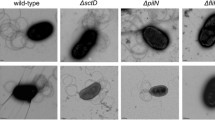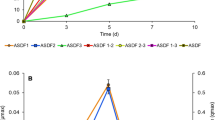Abstract
The impact of grazing by soil flagellates Heteromita globosa on aerobic biodegradation of benzene by Pseudomonas strain PS+ was examined in batch culture. Growth of H. globosa on these bacteria obeyed Monod kinetics (μmax, 0.17 ± 0.03 h−1; Ks, 1.1 ± 0.2 × 107 bacteria mL−1) and was optimal at a bacteria/ flagellate ratio of 2000. Carbon mass balance showed that 5.2% of total [ring-U-14C]benzene fed to bacteria was subsequently incorporated into flagellate biomass. Growth-inhibiting concentrations (IC50) of alkylbenzenes (benzene, toluene, ethylbenzene) were inversely related with their octanol/ water partitioning coefficients, and benzene was least toxic for bacteria and flagellates with IC50 values of 4392 (± 167) μM and 2770 (± 653) μM, respectively. The first-order rate constant for benzene degradation (k1, 0.48 ± 0.12 day−1) was unaffected by the presence or absence of flagellates in cultures. However, the rate of benzene degradation by individual bacteria averaged three times higher in the presence of flagellates (0.73 ± 0.13 fmol cell−1 h−1) than in their absence (0.26 ± 0.03 fmol cell−1 h−1). Benzene degradation also coincided with higher levels of dissolved oxygen and a higher rate of nitrate reduction in the presence of flagellates (p < 0.02). Grazing by flagellates may have increased the availability of dissolved oxygen to a smaller surviving population of bacteria engaged in the aerobic reactions initiating benzene degradation. In addition, flagellates may also have increased the rate of nitrate reduction through the excretion of acetate as an additional electron donor for these bacteria. Indeed, acetate was shown to progressively accumulate in cultures where flagellates grazed on heat-killed bacteria. This study provided evidence that grazing flagellates stimulate bacterial degradation of alkylbenzenes and provide a link for carbon cycling to consumers at higher trophic levels. This may have important implications for bioremediation processes.




Similar content being viewed by others
References
GA Biagini BJ Finlay D Lloyd (1998) ArticleTitleProtozoan stimulation of anaerobic microbial activity: enhancement of the rate of terminal decomposition of organic matter. FEMS Microbiol Ecol 27 1–8 Occurrence Handle10.1016/S0168-6496(98)00045-2 Occurrence Handle1:CAS:528:DyaK1cXls1Oku7k%3D
DA Caron (1994) ArticleTitleInorganic nutrients, bacteria, and the microbial loop. Microb Ecol 28 295–298 Occurrence Handle10.1007/BF00166820 Occurrence Handle1:CAS:528:DyaK2MXit1Wktbk%3D
J Dolfing J Zeyer P Binder-Eicher RP Schwarzenbach (1990) ArticleTitleIsolation and characterization of a bacterium that mineralizes toluene in the absence of molecular oxygen. Arch Microbiol 154 336–341 Occurrence Handle10.1007/BF00276528 Occurrence Handle1:CAS:528:DyaK3cXmtVyjtbk%3D Occurrence Handle2244785
F Ekelund (1996) ArticleTitleGrowth kinetics of five common heterotrophic soil flagellates. Eur J Soil Biol 32 15–24
T Fenchel (1982) ArticleTitleEcology of heterotrophic microflagellates II. Bioenergetics and growth. Mar Ecol Prog Ser 8 225–231
T Fenchel (1987) Ecology of Protozoa Springer-Verlag Berlin
RJ Geider BSC Leadbeater (1988) ArticleTitleKinetics and energetics of growth of the marine choanoflagellate Stephanoeca diplocostata. Mar Ecol Prog Ser 47 169–177
HJ Heipieper R Diefenbach H Keweloh (1992) ArticleTitleConversion of cis unsaturated fatty acids to trans, a possible mechanism for the protection of phenol-degrading Pseudomonas putida P8 from substrate toxicity. Appl Environ Microbiol 58 1847–1852 Occurrence Handle1:CAS:528:DyaK38XksVCgsro%3D Occurrence Handle1622260
P Holubar T Grudke A Moser B Strenn R Braun (2000) ArticleTitleEffects of bacterivorous ciliated protozoans on degradation efficiency of a petrochemical activated sludge process. Wat Res 34 2051–2060 Occurrence Handle10.1016/S0043-1354(99)00378-4 Occurrence Handle1:CAS:528:DC%2BD3cXitFyis74%3D
HW Hunt CV Cole DA Klein DC Coleman (1977) ArticleTitleA simulation model for the effect of predation on bacteria in continuous culture. Microb Ecol 3 259–278 Occurrence Handle1:CAS:528:DyaE1cXhvV2nug%3D%3D
A Inoue K Horikoshi (1989) ArticleTitleA Pseudomonas thrives in high concentrations of toluene. Nature 338 264–266 Occurrence Handle1:CAS:528:DyaL1MXhslSit7s%3D
S Isken JAM de Bont (1998) ArticleTitleBacteria tolerant to organic solvents. Extremophiles 2 229–238 Occurrence Handle1:CAS:528:DyaK1cXmtVOqt7Y%3D Occurrence Handle9783170
NE Kinner RW Harvey DM Shay DW Metge A Warren (2002) ArticleTitleField evidence for a protistan role in an organically-contaminated aquifer. Environ Sci Technol 36 4312–4318 Occurrence Handle1:CAS:528:DC%2BD38XmvVGnsbk%3D Occurrence Handle12387403
H Körner WG Zumft (1989) ArticleTitleExpression of denitrification enzymes in response to the dissolved oxygen and respiratory substrate in continuous culture of Pseudomonas stutzeri. Appl Environ Microbiol 55 1670–1676 Occurrence Handle2764573
S Kota RC Borden MA Barlaz (1999) ArticleTitleInfluence of protozoan grazing on contaminant biodegradation. FEMS Microbiol Ecol 29 179–189 Occurrence Handle1:CAS:528:DyaK1MXksVygt70%3D
EL Madsen JL Sinclair WC Ghiorse (1991) ArticleTitleIn situ biodegradation: microbiological patterns in a contaminated aquifer. Science 252 830–833 Occurrence Handle1:CAS:528:DyaK3MXisFelu7w%3D Occurrence Handle2028258
RG Mattison S Harayama (2001) ArticleTitleThe predatory soil flagellate Heteromita globosa stimulates toluene biodegradation by a Pseudomonas sp. FEMS Microbiol Lett 194 39–45 Occurrence Handle1:CAS:528:DC%2BD3MXitl2nsQ%3D%3D Occurrence Handle11150663
RG Mattison H Taki S Harayama (2002) ArticleTitleThe bacterivorous soil flagellate Heteromita globosa reduces bacterial clogging under denitrifying conditions in sand-filled aquifer columns. Appl Environ Microbiol 68 4539–4545 Occurrence Handle1:CAS:528:DC%2BD38XmvVCjs7c%3D Occurrence Handle12200311
Newell, CJ, Rifai, HS, Wilson, JT, Connor, JA, Aziz, JA, Suarez, MP (2002) Calculation and use of first-order rate constants for monitored natural attenuation studies. EPA/540/S-02/500, http://www.epa.gov/ada/publications.html
G Novarino A Warren H Butler G Lambourne A Boxshall J Bateman NE Kinner RW Harvey RA Mosse B Teltsch (1997) ArticleTitleProtistan communities in aquifers: a review. FEMS Microbiol Rev 20 261–275 Occurrence Handle1:CAS:528:DyaK2sXltl2qs70%3D Occurrence Handle9299706
FC Page (1988) A New Key to Freshwater and Soil Gymnamoebae Freshwater Biological Association Ambleside, Cumbria (UK)
HC Pinkart JW Wolfram R Rogers DC White (1996) ArticleTitleCell envelope changes in solvent-tolerant and solvent-sensitive Pseudomonas putida strains following exposure to o-xylene. Appl Environ Microbiol 62 1129–1132 Occurrence Handle1:CAS:528:DyaK28XhsVWqtL8%3D
JL Ramos E Duque JJ Rodríguez-Herva P Godoy A Haïdour F Reyes A Fernández-Barrero (1997) ArticleTitleMechanisms for solvent tolerance in bacteria. J Biol Chem 272 3887–3890 Occurrence Handle1:CAS:528:DyaK2sXht1Olsb4%3D Occurrence Handle9020089
CH Ratsak KA Maarsen SALM Kooijman (1996) ArticleTitleEffects of protozoa on carbon mineralization in activated sludge. Wat Res 30 1–12 Occurrence Handle1:CAS:528:DyaK2MXpsleju78%3D
A Rogerson J Berger (1983) ArticleTitleEnhancement of the microbial degradation of crude petroleum by the ciliate Colpidium colpoda. J Gen Appl Microbiol 29 41–50 Occurrence Handle1:CAS:528:DyaL3sXitFalsLs%3D
A Rogerson WY Shiu GL Huang D Mackay J Berger (1983) ArticleTitleDetermination and interpretation of hydrocarbon toxicity to ciliate protozoa. Aquat Toxicol 3 215–228 Occurrence Handle1:CAS:528:DyaL3sXitFWju7w%3D
P Roslev PL Madsen JB Thyme K Henriksen (1998) ArticleTitleDegradation of phthalate and di-(2-ethylhexyl)phthalate by indigenous and inoculated microorganisms in sludge-amended soil. Appl Environ Microbiol 64 4711–4719 Occurrence Handle1:CAS:528:DyaK1cXnvF2hsL8%3D Occurrence Handle9835553
RW Sanders DA Caron UG Berninger (1992) ArticleTitleRelationship between bacteria and heterotrophic nanoplankton in marine and freshwaters: an inter-ecosystem comparison. Mar Ecol Prog Ser 86 1–14
BF Sherr EB Sherr T Berman (1982) ArticleTitleDecomposition of organic detritus: a selective role for microflagellate protozoa. Limnol Oceanogr 27 765–769 Occurrence Handle1:CAS:528:DyaL38XltVKkurs%3D
BF Sherr EB Sherr J McDaniel (1992) ArticleTitleEffect of protistan grazing on the frequency of dividing cells in bacterioplankton assemblages. Appl Environ Microbiol 58 2381–2385
JL Sinclair DH Kampbell ML Cook JT Wilson (1993) ArticleTitleProtozoa in subsurface sediments from sites contaminated with aviation gasoline or jet fuel. Appl Environ Microbiol 59 467–472
RR Sokal FJ Rohlf (1981) Biometry: The Principles and Practice of Statistics in Biological Research WH Freeman San Francisco
JJ van Hellemond FR Opperdoes AGG Tielens (1998) ArticleTitleTrypanosomatidae produce acetate via mitochondrial acetate:succinate CoA transferase. Proc Natl Acad Sci USA 95 3036–3041 Occurrence Handle1:CAS:528:DyaK1cXitV2itLw%3D Occurrence Handle9501211
J van Rijn Y Tal Y Barak (1996) ArticleTitleInfluence of volatile fatty acids on nitrite accumulation by a Pseudomonas stutzeri strain isolated from a denitrifying fluidized bed reactor. Appl Environ Microbiol 62 2615–2620 Occurrence Handle1:CAS:528:DyaK28XjvFGmtrk%3D
B Zarda G Mattison A Hess D Hahn P Hohener J Zeyer (1998) ArticleTitleAnalysis of bacterial and protozoan communities in an aquifer contaminated with monoaromatic hydrocarbons. FEMS Microbiol Ecol 27 141–152 Occurrence Handle1:CAS:528:DyaK1cXmtl2ntr8%3D
MV Zubkov MA Sleigh (1999) ArticleTitleGrowth of amoebae and flagellates on bacteria deposited on filters. Microb Ecol 37 107–115 Occurrence Handle9929399
KB Zwart JF Darbyshire (1992) ArticleTitleGrowth and nitrogenous excretion of a common soil flagellate Spumella sp.—a laboratory experiment. J Soil Sci 43 145–157 Occurrence Handle1:CAS:528:DyaK38XktVeqtbk%3D
Acknowledgments
The authors thank the New Energy and Industrial Technology Development Organization (NEDO) for funding this study under the project “Development of Technologies for Analyzing and Controlling the Mechanism of Biodegrading and Processing”, and also for providing a personal fellowship to R.G.M.
Author information
Authors and Affiliations
Corresponding author
Rights and permissions
About this article
Cite this article
Mattison, R., Taki, H. & Harayama, S. The Soil Flagellate Heteromita globosa Accelerates Bacterial Degradation of Alkylbenzenes through Grazing and Acetate Excretion in Batch Culture. Microb Ecol 49, 142–150 (2005). https://doi.org/10.1007/s00248-003-0226-5
Received:
Accepted:
Published:
Issue Date:
DOI: https://doi.org/10.1007/s00248-003-0226-5




